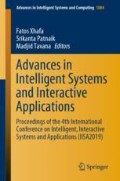Abstract
With the rapid development of artificial intelligence technology of deep learning method, it has been applied to many fields, especially to life science. In this paper, a novel approach for the task of voiceprint recognition was proposed. The combination of deep belief network (DBN) and support vector machine (SVM) was used to identify the voiceprint of 10 different individuals. Based on a 24-dimension Mel Frequency Cepstrum Coefficient (MFCC), the authors extracted 256-dimension deep voiceprint features via DBN model that is developed by stacking three layers of Restricted Boltzmann Machine (RBM), and conducted voiceprint recognition by approach of SVM. According to the recognition results, the new approach can significantly improve both of accuracy and efficiency when it was compared with traditional voiceprint features and recognition models. The low dimensional features of voiceprint was extracted into higher dimensions by DBN model, while SVM can avoid the elevation of computation complexity caused by the increases of feature dimension. The combined strengths have been fully expressed by the experimental results.
Access this chapter
Tax calculation will be finalised at checkout
Purchases are for personal use only
References
Campbell, J.P.J.: Speaker recognition: a tutorial. Proc. IEEE 85(9), 1437–1462 (2008)
Davis, S.B., Mermelstein, P.: Comparison of parametric representations for monosyllabic word recognition in continuously spoken sentences. IEEE Trans. Acoust. Speech Signal Process. 28(4), 357–366 (1980)
Doddington, G.R.: Speaker recognition-identifying people by their voices. Proc. IEEE 73(11), 1651–1664 (1985)
Shikano, K.: Text-independent speaker recognition experiments using codebooks in vector quantization. J. Acoust. Soc. Am. 77(S11), 57–68 (1985)
Waibel, A.: Modular Construction of Time-Delay Neural Networks for Speech Recognition. MIT Press, Cambridge (1989)
Reynolds, D.A., Rose, R.C.: Robust text-independent speaker identification using Gaussian mixture speaker models. IEEE Trans. Speech Audio Process. 3(1), 72–83 (1995)
Campbell, W.M., Sturim, D.E., Reynolds, D.A., et al.: SVM based speaker verification using a GMM super vector kernel and NAP variability compensation. In: IEEE International Conference on Acoustics, Speech and Signal Processing. ICASSP 2006 Proceedings, 2006:I-I. IEEE (2006)
Kenny, P., Boulianne, G., Ouelletm, P., Dumouchel, P.: Speaker and session variability in GMM-based speaker verification. IEEE Trans. Audio Speech Lang. Process. 15(4), 1448 (2007)
Kenny, P., Boulianne, G., Ouellet, P., Dumouchel, P.: Speaker and session variability in GMM-based speaker verification. IEEE Trans. Audio Speech Lang. Process. 15(4), 1435–1447 (2007)
Dehak, N., Kenny, P.J., Dehak, R., Dumouchel, P., Ouellet, P.: Front-end factor analysis for speaker verification. IEEE Trans. Audio Speech Lang. Process. 19(4), 788–798 (2011)
Hinton, G.E., Osindero, S., Teh, Y.-W.: A fast learning algorithm for deep belief nets. Neural Comput. 18(7), 1527–1554 (2006)
Mohamed, A., Dahl, G., Hinton, G.: Deep belief networks for phone recognition. In: Nips Workshop on Deep Learning for Speech Recognition and Related Applications, vol. 1(9), pp. 39 (2009)
Hinton, G., Deng, L., Yu, D., et al.: Deep neural networks for acoustic modeling in speech recognition: the shared views of four research groups. IEEE Signal Process. Mag. 29(6), 82–97 (2012)
Wu, M.: A Study of Text-Independent Speaker Recognition Based on Deep Learning. University of Science and Technology of China (2016)
Lv, L.: A Study of Voiceprint Recognition Methods based on Deep Learning. Southeast University (2016)
Zhijun, S., Lei, X., Yangming, X., et al.: The research overview of deep learning. Appl. Res. Comput. 29(8), 2806–2810 (2012)
Chunxia, Z., Nannan, J., Guanwei, W.: Restricted boltzmann machine. Chin. J. Eng. Math. 32(2), 161–175 (2015)
Jinhui, L., Junan, Y., Yi, W.: New feature extraction method based on bottleneck deep belief networks and its application in language recognition. Comput. Sci. 41(3), 263–266 (2014)
Acknowledgments
This work was partially supported by the National Natural Science Foundation of P. R. China (No. 11401092, 11426045), Scientific and Technological Planning Project of Ji Lin Province of P. R. China (No. 20180101229JC), Foundation of Ji Lin Educational Committee (No. JJKH20181100KJ).
Author information
Authors and Affiliations
Corresponding author
Editor information
Editors and Affiliations
Rights and permissions
Copyright information
© 2020 Springer Nature Switzerland AG
About this paper
Cite this paper
Han, L. et al. (2020). Recognition of Voiceprint Using Deep Neural Network Combined with Support Vector Machine. In: Xhafa, F., Patnaik, S., Tavana, M. (eds) Advances in Intelligent Systems and Interactive Applications. IISA 2019. Advances in Intelligent Systems and Computing, vol 1084. Springer, Cham. https://doi.org/10.1007/978-3-030-34387-3_1
Download citation
DOI: https://doi.org/10.1007/978-3-030-34387-3_1
Published:
Publisher Name: Springer, Cham
Print ISBN: 978-3-030-34386-6
Online ISBN: 978-3-030-34387-3
eBook Packages: Intelligent Technologies and RoboticsIntelligent Technologies and Robotics (R0)

